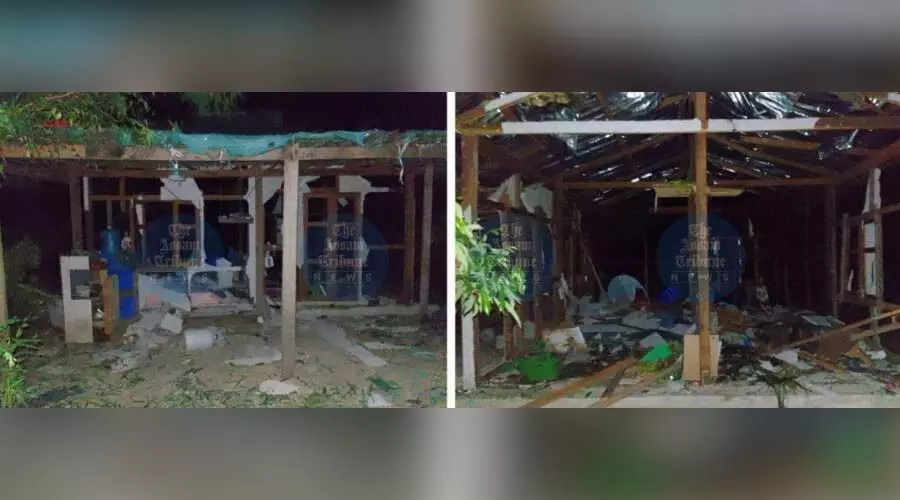Drone strike on ULFA-I camps kills 3 top cadres; sources cite 3 Corps ops, Army denies role
Condemning the act, the banned outfit has criticised several media houses for choosing to report based on "transcripts provided by the occupying forces of the colonial Indian state".

Over 100 drones were launched targeting two key bases of the outfit in Myanmar, on Sunday. (AT Photo)
Guwahati, July 14: In a major offensive, Indian security forces launched aerial attacks on ULFA(I) camps in Myanmar in the wee hours of Sunday, killing at least three senior cadres of the outfit besides injuring several others.
Sources said that over 100 drones were launched targeting two key bases of the outfit – ‘Diamond Camp’ near Hoyat village and the ‘central mobile headquarters’ located in the Waktham area in Myanmar.
The outfit admitted the strikes and claimed that self-styled Lt Gen Nayan Asom, ‘brigadier’ Ganesh Asom and ‘Col’ Pradip Asom were killed and at least 19 other cadres were injured. It was a major setback to the outfit after Myanmar army’s crackdown, codenamed ‘Operation Sunrise’, in 2019.
Officially, Indian Army denied the attacks. “There is no input from Indian Army on such operation,” defence spokesman Lt Col Mahendra Rawat said.
However, sources confirmed that the strikes were launched from forward areas of the Rangapahar-based 3 Corps and the spadework, including reconnaissance and marking of coordinates of the targets, was done over the last few days.
“The aerial distance of the targeted camps is around 10-15 km from the Indo-Myanmar border. A highly technical team carried it out with precision,” the sources said, adding that launchers were also used.
The ULFA(I) camp in Hoyat is located in the vicinity of NSCN/K-Angmai camp and a new base of NSCN-IM ‘Veda Peace Mission Command’. It is, however, not clear if the camps of other outfits were also affected.
The ULFA(I) mailed three statements to the media since this morning. In the first mail, it claimed that Israel and France-made drones were used to carry out the strikes between Longwa along Nagaland-Myanmar border and Pangso Pass on Arunachal Pradesh-Myanmar border from 2 am to 4.30 am. Over 100 drones targeted the militant camps, killing Nayan Asom and 19 cadres.
The second attack, which killed Ganesh Asom and Pradip Asom, was carried out while the funeral of Nayan Asom was going on, the outfit’s second statement stated, also claiming that civilians were also injured. Camps of PLA were also attacked, it claimed.
The ULFA(I) said that despite the “cowardly” strikes, it remains steadfast in its goals and objectives, and vowed retaliation.
Sources said the strikes were “pre-emptive”, as the ULFA(I) had been active in recent times and was planning subversive activities. “All the three cadres killed were sighted in Mon district in recent times and they were planning attacks in Assam,” the sources said, adding that the restive situation in Myanmar has helped the outfit to revive its activities.
Besides the two camps that were hit, the ULFA(I) also has the ‘Arakan Camp’ co-located with Yung Aung’s Lenghon camp near Lahon in Nanyun township (a joint camp with PLA, UNLF/Koireng) and another at Hakhi in the Pangsau area. The present cadre strength of the outfit is estimated to be between 250 and 400.
According to reports Nayan Kalita alias Nayan Medhi alias Nayan Asom, a senior ULFA(I) leader who was killed in Myanmar on Sunday, hailed from Dumuria village in Bajali district. Soon after receiving the news of his demise, villagers thronged his residence.
A meritorious student, Nayan left home in 1989 after completing his higher secondary. He had left a note, requesting his elder brother to delete his name from the list of family members. The elder brother informed that his last encounter with Nayan was in 1998, and thereafter he had no connection with him.
Meanwhile condemning the act, the banned outfit has criticised several media houses for choosing to report based on "transcripts provided by the occupying forces of the colonial Indian state".
“This act of echoing the narrative of the aggressors, driven by business interests, is a grave disservice to the journalistic integrity of Assam,” a loose translation of the press release read.
